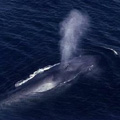美國最高法院23日受理美國海軍所提出的要求,將覆審初等法院裁示海軍在南加州外海進行潛艇偵防訓練活動,不得使用猛爆聲納聲響之限令。
 美國海軍在其內部針對軍事訓練活動的環境評估中,承認目前在南加州海域所使用的聲納系統,將會干擾或甚至傷害逾170,000隻海洋哺乳動物,包括在超過450隻鯨魚身上造成永久性傷害,以及導致至少8,000隻鯨魚出現暫時性聽覺障礙的結果。
美國海軍在其內部針對軍事訓練活動的環境評估中,承認目前在南加州海域所使用的聲納系統,將會干擾或甚至傷害逾170,000隻海洋哺乳動物,包括在超過450隻鯨魚身上造成永久性傷害,以及導致至少8,000隻鯨魚出現暫時性聽覺障礙的結果。
此項限用聲納的基礎訴訟係由美國「自然資源保護協會」(Natural Resources Defense Council, NRDC),帶領保育組織聯盟共同提出。
在環保團體稱聲納系統危害海洋哺乳動物的指控下,美國第九巡迴上訴法庭曾於2008年2月29日裁示,允准海軍繼續於南加州海域進行訓練操演,不過在使用中頻主動聲納方面,須搭配更為嚴謹的環境保護措施。美國海軍不滿法庭裁決的附帶條件,於同年4月要求最高法院進行覆審。
南加州外海育有5種瀕臨絕種的鯨魚、全球最重要的瀕絕藍鯨群,以及7種喙鯨等豐富的生態,卻因為這些海洋哺乳動物對水下聲音特別敏感,顯得格外脆弱。而保育人士關切的對象不只是鯨類,還包括聲納於所及範圍內,對所有生物的影響。
先前法庭裁定的中頻主動聲納訓練使用限制包括,當船艦方圓2,200碼內出現海洋哺乳動物活動,須強制關閉聲納系統,以及當海軍偵測海面航道情形時,不論是否有海洋哺乳動物在附近活動,一律降低75%之功率。
 美國海軍第三艦隊指揮官洛克萊(Vice Adm. Samuel J. Locklear)表示,「我的首要職責在於確使海軍艦隊在太平洋地區維持高戰備狀態,且贏得戰爭」。「但是在這些重重限制下,要能進行實戰、混合演習活動,維持我軍戰鬥力,變得窒礙難行。」
美國海軍第三艦隊指揮官洛克萊(Vice Adm. Samuel J. Locklear)表示,「我的首要職責在於確使海軍艦隊在太平洋地區維持高戰備狀態,且贏得戰爭」。「但是在這些重重限制下,要能進行實戰、混合演習活動,維持我軍戰鬥力,變得窒礙難行。」
洛克萊不滿地指出,2200碼的聲納禁用區是美國海軍現行禁用範圍的11倍大,且現行的標準是經同「國家海洋漁業局」(National Marine Fisheries Service)協議的結果。另外,船艦正在執行海面航道情況勤務時,不論有無海洋哺乳動物動物出沒,一律降低聲納使用功率75%的規定,將會阻礙海軍戰鬥群在進行演習訓練時,不易偵得潛匿中的潛艇。
美國海軍高級將領表示,海軍正積極建立高效戰鬥力與環境保護之間的平衡。海軍於2008年度投入2,600萬美元,資助海洋哺乳動物的研究。此外,當海軍於「重要行動期間、或於決勝區或作戰區內」使用中頻主動聲納時,同樣固守著國家海洋漁業局所同意的海洋哺乳動物保護措施。
況且,美國國防部曾於2007年1月23日,授權海軍的海事活動在「海洋哺乳動物保護法案」(Marine Mammal Protection Act)下,享有為期兩年的國防豁免權,其中包括中頻主動聲納的使用。
The U.S. Supreme Court today accepted a request by the U.S. Navy that the court review a series of lower court rulings that restrict the Navy's use of loud sonar blasts in submarine detection training exercises off the coast of Southern California.
The Navy, in its official environmental assessment of the exercises, acknowledges sonar use now underway in Southern California waters will disturb or injure an estimated 170,000 marine mammals, including causing permanent injury to more than 450 whales and temporary hearing impairment in at least 8,000 whales.
The underlying lawsuit was brought by a coalition of conservation organizations led by the Natural Resources Defense Council, NRDC.
In April, the Navy petitioned the Court for review of the February 29, 2008 decision by the Ninth Circuit Court of Appeals, allowing naval training exercises to continue in the Southern California region but with greater environmental safeguards in the use of mid-frequency active sonar that the environment groups claim harms marine mammals.
The waters off Southern California hold five endangered species of whales, a globally important population of endangered blue whales and seven species of beaked whales, which are known to be particularly vulnerable to underwater sound, but the environmentalists are concerned not only about whales but about all creatures that experience these loud sounds.
The court-imposed mid-frequency active sonar training restrictions include a requirement to shut down sonar altogether when marine mammals are within 2,200 yards of any sonar source and to reduce sonar power by 75 percent when the Navy detects significant surface ducting conditions, whether or not a marine mammal is present.
"My primary job is to ensure that Navy ships in the Pacific are prepared to fight and win in combat," said Vice Adm. Samuel J. Locklear, Commander, U.S. Third Fleet. "These restrictions make it very difficult to conduct the kind of realistic, integrated training exercises that ensure the combat effectiveness of our force."
The 2,200-yard shutdown zone is 11 times greater than the existing shutdown distance that the Navy developed in consultation with the National Marine Fisheries Service. The requirement to reduce sonar power by 75 percent during significant surface ducting conditions, whether or not a marine mammal is present, will prevent Navy strike groups from conducting training to detect submarines in the same conditions in which submarines seek to hide, the commander said.
The top Navy official says the Navy is trying to strike a balance between the need for an effective combat force and protecting the environment. The Navy is spending $26 million on marine mammal research this year. When using mid-frequency active sonar "during major exercises or within established DoD ranges or operating areas," officials say the Navy adheres to marine mammal protective measures approved by the National Marine Fisheries Service.
On January 23, 2007, the Department of Defense announced authorization of a two-year national defense exemption from requirements of the Marine Mammal Protection Act for naval activity involving mid-frequency active sonar use.
全文及圖片詳見:ENS





